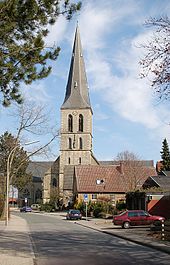St. Dionysius (Nordwalde)
The Catholic parish church of St. Dionysius is a listed church building in Nordwalde .
history
The church was built as a hall church in the 15th century . The deep vaults of the nave rest on round pillars. The 19th and 20th centuries brought radical structural changes for the three-aisled, three-bay church. The old church tower collapsed as early as 1815 and when a new one with a “late baroque” hood was erected, the nave was extended by a yoke in the west. This tower burned down on Jacob's Day in 1894 and two more western bays and the tower with a pointed dome that is still present today were added. From 1962 to 1965 the parish church got two transepts of the Gothic building with a width of two bays, whereby these were replaced by a much higher vault. Thus, only the choir and the former (until 1815) westernmost vaulted area of the old church are preserved. The two transepts have recently been separated from the church and housed the parish hall and the parish library. A neo-baroque high altar by the Ochsenfarth company (Paderborn), made in 1983 on the occasion of the discovery of three altar paintings from around 1700 and 1750, has been in the cemetery chapel of Przyschetz , a village near Proskau (Poland) , since 2011 .
Furnishing
- Gothic tabernacle in the form of a wall tabernacle.
- Tendril painting based on late Gothic findings from the choir on the vaulted fields, except for the side aisle vaults from 1962.
- Copies of Gothic apostles on the pillars, polychromed. The originals are in the St. Sebastian parish church in Münster-Nienberge .
- Acquired baroque cross paintings from Yugoslavia and re-framed. The carved neo-Gothic predecessors adorn the chapel in the cemetery on Altenberger Straße.
- Epitaph with depiction of a cross from 1670.
- Epitaph depicting the “Seven Sorrows of Mary”, 18th century.
- War memorial from 1920.
- Neo-Gothic font from 1865, new cover 1979, this has already been removed and integrated into a sculpture "850 Years of Christianity in Nordwalde".
- The rest of the equipment is modern and dates from the expansion from 1962 to 1965.
- Lent cloth based on the Marienfeld model (made in 1952 in the monastery "Zum Guten Hirten Münster"); the previous cloth of the same type from 1860 is considered lost.
Bensmann organ
In the church there is an example of Westphalian-North German organ building art , the baroque organ by Dieter Bensmann (2000) behind the prospectus by Heinrich Mencke from 1711. The instrument has been a listed building since 2000. The prospectus stood in the Freckenhorst collegiate church until the 1960s , where it was dismantled and stored.
The register names have been adapted to today's spelling, but go back to the names from the treaty of 1706. The instrument has 25 stops on 2 manuals and a pedal. The actions are mechanical.
|
|
|
||||||||||||||||||||||||||||||||||||||||||||||||||||||||||||||||||||||||||||||||||||||||||||||||||||||||||||||||||||||||||||
- Coupling: II / I, I / P, II / P
literature
- Architectural monuments, Rhineland and Westphalia. Reclam's Art Guide, Germany, Volume III, 1975.
- Karl-Heinz Stening: Church leader, parish church St. Dionysius Nordwalde. Wietheger, Nordwalde.
- Thorsten Schlepphorst, Dieter Bensmann, Daniel Lembeck, Ulrich Reinke: The new Bensmann organ in the Catholic parish church of St. Dionysius Nordwalde. Marius Jacoby publishing house, ISBN 3-936434-00-X
Web links
Individual evidence
- ↑ Reclam's art guide, architectural monuments, Rhineland and Westphalia, Germany Volume III, 1975, pages 571 u. 572
- ↑ Westfälische Nachrichten of July 21, 2011, “A visit to the Black Madonna”.
- ↑ Paul Engelmeier: Westphalian hunger scarves from the 14th to the 19th century . Munster 1961.
- ↑ More information about the baroque organ. Retrieved December 3, 2014 .
Coordinates: 52 ° 5 ′ 7 ″ N , 7 ° 28 ′ 49 ″ E


